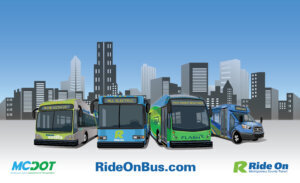This content is provided by MCDOT.
 For the past 47 years, Ride On has been at the forefront of transit growth and opportunity in Montgomery County. The bus service has continued to learn and adapt to the growing needs of the community, economy and environment. To fully grasp where Ride On is headed, it’s worth looking at where it has been.
For the past 47 years, Ride On has been at the forefront of transit growth and opportunity in Montgomery County. The bus service has continued to learn and adapt to the growing needs of the community, economy and environment. To fully grasp where Ride On is headed, it’s worth looking at where it has been.
The Ride On system, the first county-run bus service in the Washington, DC area, debuted in 1975 with 20 buses and was designed to provide service in Takoma Park and Silver Spring where large buses could not travel. The service also included a dial-a-ride operation in Gaithersburg. Deemed to be more efficient economically than other public transportation options at the time, within weeks of its introduction, the bus service was transporting twice the number of riders originally projected – nearly 2,000 passengers each day.
Three years after Ride On started service, Montgomery County expanded the popular bus service to 22 routes with 79 buses. This move increased ridership from about 4,000 passengers per day to more than 12,000.
The bus service extended to include Silver Spring, Takoma Park, Langley Park, White Flint and Wheaton. The Silver Spring Metro station was the focal point. At this time, the Ride On fare was 25 cents and operated Monday through Saturday from 6 a.m. until 8 p.m. with six routes running on Sunday. The first Ride On buses had seats for 19 passengers and cost about $21,000 each. By 1978, 23- to 27- seaters were being phased in at $30,000 a bus.
Once Metro’s Red Line extension to Shady Grove was up and running in 1984, Ride On added more than 20 routes. The buses transported passengers to their jobs in Rockville, Germantown and Gaithersburg. By 1986, additional service started to Damascus and Urbana from Shady Grove and ridership was at 10 million a year.
Ride On celebrated its 25th anniversary in 2000 by painting two buses uniquely to commemorate the milestone and offered 25-cent daily fares and $1.50 regional passes for all passengers for the rest of the year. The bus service offered free weekday rides with its “Kids Ride Free” program.
In 2006, Ride On began accepting SmarTrip® cards. In addition, Ride On debuted its first hybrid-electric buses and had 13 operating by the end of 2007.
In recent years, Ride On has expanded to operate three additional services: Ride On extRa, Ride On Flex and Flash Bus Rapid Transit (BRT). Ride On extRa limited stop service, which started in 2017, runs on Maryland Route 355 making 13 stops between Medical Center Station and the Lakeforest Mall Transit Center. Ride On Flex is an on-demand bus service that began operating in 2019. It carries passengers around Rockville, Glenmont and Wheaton designated service areas. Riders can request service by using an app or the call center. Flash BRT began offering rapid transit along U.S. Route 29 in 2020, which featured faster service with high-capacity buses. Additional Flash BRT lines are being designed along Veirs Mill Road, MD 355, New Hampshire Avenue and in North Bethesda.
Ride On’s first four all electric buses began service in 2020 in Silver Spring/Takoma Park. Ten more electric buses will be added this year and a commitment has been made to transition the fleet to all electric buses by 2035. The electric buses can run a full day on a single charge, dependence on fossil fuels and offer sustainable mobility solutions since they significantly reduce GHG emissions, air and noise pollution.
In addition, County Executive Marc Elrich’s proposed Capital Improvements Budget includes $655 million in mass transit improvements to decrease the climate impact of transportation in the County, including $154 million to start to convert Ride On to a zero-emission fleet.
As Ride On looks for ways to continue to upgrade and improve service moving forward, the bus service is working on a few new initiatives. First, Ride On launched a comprehensive study – the Ride On Reimagined Study – last month. The study aims to take a critical look at the County’s current and future bus network and transit systems, including Metrobus and the planned Purple Line, to pinpoint where improvements can be made. The study is based on experience and feedback from the community.
Another program is the Bus Priority Program which was created by a group of MCDOT and Montgomery County staff members last year. The program focuses on advancements for bus operations including dedicated bus lanes, bus signal prioritization and enhanced bus stops. The first project created dedicated bus lanes around the Germantown Transit Center.
The Great Seneca Transit Network is also being designed and constructed currently. The plan is for hubs at Shady Grove Metrorail Station, the Universities at Shady Grove and Adventist Shady Grove Hospital. The service which will be branded as Ride On extRa is slated to start in 2024 and will provide transportation to jobs, education and healthcare. It will include 11 stations, dedicated bus lanes, transit signal priority at seven intersections and new bike and pedestrian connections.
Today, Ride On has a fleet of 382 ADA-accessible buses and 75% use alternative fuels. The bus system is one of the busiest, and the second largest in the region, which operates 7 days a week on over 80 routes and 5,405 bus stops. A recent report released by a regional coalition of business and smart growth organizations commends Montgomery County for its Flash bus service, free fares for Ride On service and considered a leader in many respects in regards to regional bus service.
For more information, please visit RideOnBus.com.







